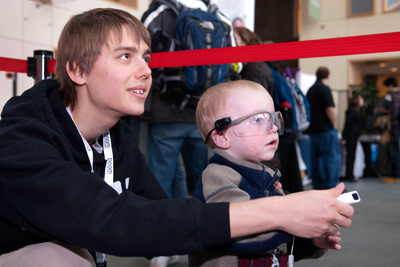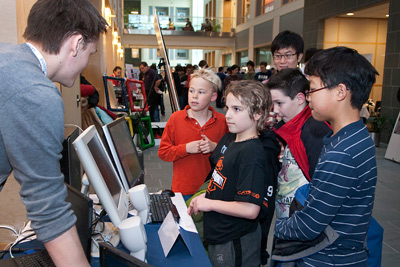BOOM showcases student projects with real-life appeal
By Farrah Tan


The 40 digital technology projects on display March 3 in Duffield Hall at the annual Bits on Our Minds (BOOM) exhibition ranged from a small, self-guided robotic helicopter to a facial recognition program for tracking ancestry or to aid in searching for missing children. Representatives from such sponsoring companies as Google, Yahoo!, Cisco Systems, Lockheed Martin, Citigroup, Morgan Stanley and Goldman Sachs were on hand to witness the action and select winners for innovation and creativity.
"There are some great concepts in both software and hardware. What we are looking for are projects that have a real-life implication, things that are very easy to apply," said Bimal Kadikal, a representative from Citigroup.
Many students attending the event were attracted to computer games created by students. "Gamut is a puzzle game where you figure out how to get past each level by changing the color of the world to make objects of that color disappear," said Ethan Benanav '10, a computer science major, of his project. Project Vertex is a game that uses the Wii remote. "This game can track where the player's head is in order to change the perspective of the 3-D virtual world, which allows you to use your own body as the controller," said Michael Wilson '11 of his project, which won the Morgan Stanley Innovation Award. "You can essentially move yourself to dodge bullets while shooting back with the Wiimote."
Other award-winning projects included Monopoly Strategy Research (a computer analysis of the board game), Spoken Language Identification and Emotion Classification, and Data Mining on Social Networking Sites, which were commended for technical competence and immediate applicability to the real world.
"Since there is so much public data of users and their opinions on certain things on social networking sites, it is useful that we analyze those expressions using machine learning and natural language processing algorithms," said Sujith Vidanapathirana, a graduate student in computer science, whose emotion classification project won the Yahoo! Excellence Award for its direct applicability to the company's interests. "Our research is useful to companies who want to mine data on what the public thinks about their products," he said.
The only biological science research project at BOOM was "Genetically Engineering a Heavy Metal Biosensor." The goal was to engineer an affordable biosensor to detect cadmium, a toxic heavy metal that contaminates irrigation water in developing nations. "Instead of just investigating biology, we now have enough theoretical principles to try manipulating it," said Kevin Cheng '10, a biology major working on this project. "Basically it's like turning biology into an engineering discipline. We can design organisms to do certain functions."
Cornell teams entering national competitions also displayed their projects, which included an automated aircraft, submarine and minesweeper, and a snakelike robot arm.
Farrah Tan '10 is a writer intern for the Cornell Chronicle.
Media Contact
Get Cornell news delivered right to your inbox.
Subscribe